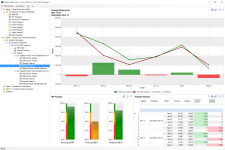 Analysis, Functionality and Collaboration
Analysis, Functionality and Collaboration
An Extensions solution is any combination of data manipulation and calculation, selection filters, analyses, tools and functionality within a structured workflow that drives the targeted business processes. The order, detail and data routines of this workflow are completely flexible, enabling the transformation of strategy into working processes. Please watch the video at the top of the preceding Overview page for a demonstration.
Data Manipulation And Calculation
Extensions solutions leverage the large volumes of data within your organisation, sometimes across disparate management information systems for a given business process. Solutions use live data wherever possible ensuring analyses are current; where the data manipulation and calculation programs are intensive, a recent data snapshot can be used, which is updated at chosen intervals. The scope and depth of this data manipulation and calculation is without limit, meaning that programs with the complexity of demand forecasting and finite capacity planning can run. Entalysis has standard add-on modules for these and other programs, but it is the no-compromise fitting of these programs to your business, accounting for all the vital quirks and exceptions, which realises the greatest benefits.
Selection Filters and Analyses
Users follow the defined workflow to select, filter, analyse and update data using any sequence of trees, editable grids, charts, dashboards, report builders and bespoke tools. This defines a common business process between staff for better efficiency and effectiveness. Extensions' reporting is completely flexible, where selected variables are recorded and used dynamically in downstream reports, rather than being a drill-down through a few hierarchical summaries to the base data of a finite dataset where further reporting stops. This no-restriction reporting depth (drill down or across) allied to the ability to crossover into separate areas of analysis (for example, sales performance to debtor performance by account) means that users can be led to the root cause and corrective actions for poor-performing KPIs, rather than just drilling-down through a few summaries in one area.
Extensions' flexibility allows bespoke calculations and formulas in addition to the standard statistical formulas, enabling any special logic your business processes require. The formatting capabilities of all the controls enable users to easily identify areas of note via grid heat maps (colour coded cells according to their numerical or textual value), in-memory filtering, summary functions and sorting. A solution's scope often spans several levels of management, from c-level executives to the shop floor, and to ensure any sensitive data or functionality are not exposed, Extensions' security features ensure only relevant reports, data and functionality are served to each user. This means that even persons external to your business involved in your processes can use Extensions, enforcing a common business process structure for all participants.
Tools and Functionality
A business process comprises action based on analysis at various stages, which involves a combination of data review, adjustment and acceptance. Extensions has the flexibility to offer the user the best means for this task, offering editable grids and bespoke tools as best befits the task. Bespoke tools offer the ultimate flexibility and the ethos here is to give the user the simplest tool possible, shielding them from unnecessary information and complexity, but ensuring they have all the functionality required. We may design a tool which manages data found on multiple forms of the host management information system, but in the simplest and most logical user interface. The editable grid is naturally the most effective tool for many data update requirements, but the flexibility of Extensions' bespoke tools allow any functionality needed. This updated data is then fed back into the host management information system and/ or Extensions' data tables for use in data manipulation and calculation programs.
Next, read about configuring and administering Extensions.